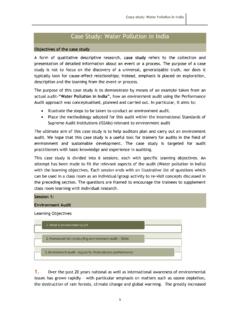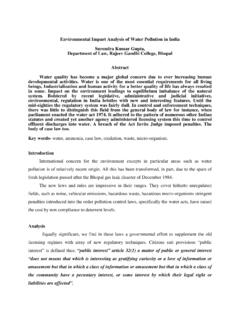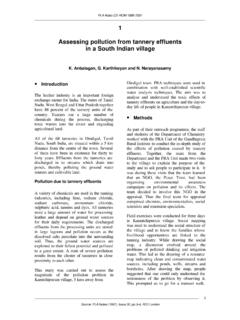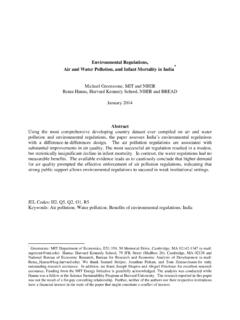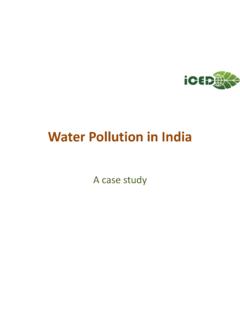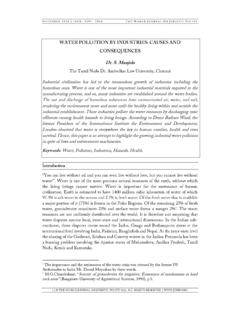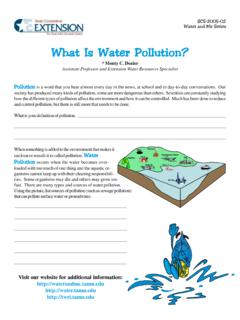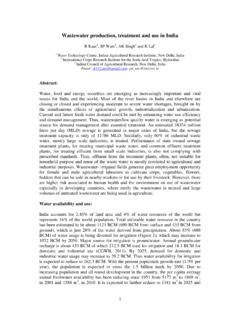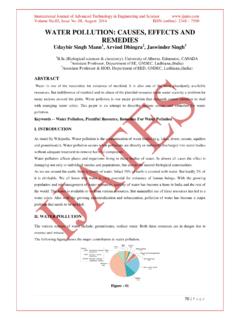Transcription of Environmental Regulations, Air and Water Pollution, and ...
1 American Economic Review 2014, 104(10): 3038 3072 Regulations, Air and Water pollution , and Infant Mortality in india By Michael Greenstone and Rema Hanna*Using the most comprehensive developing country dataset ever compiled on air and Water pollution and Environmental regulations, the paper assesses india s Environmental regulations with a difference-in-differences design. The air pollution regulations are associated with substantial improvements in air quality. The most successful air regulation resulted in a modest but statistically insignificant decline in infant mortality. In contrast, the Water regulations had no measurable benefits. The available evidence leads us to cautiously conclude that higher demand for air quality prompted the effective enforcement of air pollution regulations, indicating that strong public support allows Environmental regulations to succeed in weak institutional settings.
2 (JEL I12, J13, O13, Q53, Q58)Weak institutions are a key impediment to advances in well-being in many devel-oping countries. Indeed, an extensive literature has documented many instances of failed policy in these settings and has been unable to identify a consistent set of ingredients necessary for policy success (Banerjee, Duflo, and Glennerster 2008; Duflo et al. 2012; Banerjee, Hanna, and Mullainathan 2013). The specific question of how to design effective Environmental regulations in developing countries with weak institutions is increasingly important for at least two First, local pollutant concentrations are exceedingly high in many developing countries and in many instances are increasing (Alpert, Shvainshtein, and Kishcha 2012).
3 Further, the high pollution concentrations impose substantial health costs, including shortened lives (Chen et al. 2013; Cropper 2010; Cropper et al. 2012), so understanding the most efficient ways to reduce local pollution could significantly improve well-being. 1 There is a large literature measuring the impact of Environmental regulations on air quality, with most of the research focused on the United States. See, for example, Chay and Greenstone (2003, 2005), Greenstone (2003, 2004), Henderson (1996), and Hanna and Oliva (2010), etc. The institutional differences between the United States and many developing countries mean that the findings are unlikely to be valid for predicting the impacts of environ-mental regulations in developing countries.
4 * Greenstone: MIT Department of Economics, E52-359, 50 Memorial Drive, Cambridge, MA 02142-1347 (e-mail: Hanna: Harvard Kennedy School, 79 JFK Street (Mailbox 26), Cambridge, MA 02138, and National Bureau of Economic Research, Bureau for Research and Economic Analysis of Development (e-mail: We thank Samuel Stolper, Jonathan Petkun, and Tom Zimmermann for truly outstanding research assistance. In addition, we thank Joseph Shapiro and Abigail Friedman for excel-lent research assistance. Funding from the MIT Energy Initiative is gratefully acknowledged. The analysis was conducted while Hanna was a fellow at the Science Sustainability Program at Harvard University. The research reported in this paper was not the result of a for-pay consulting relationship.))
5 Further, neither of the authors nor their respective institutions have a financial interest in the topic of the paper that might constitute a conflict of interest. Go to to visit the article page for additional materials and author disclosure statement(s).3039 GREENSTONE AND HANNA: Environmental REGULATION IN INDIAVOL. 104 NO. 10 Second, the Copenhagen Accord makes it clear that it is up to individual countries to devise and enforce the regulations necessary to achieve their national commitments to combat global warming by reducing greenhouse gas emissions (GHG). Since most of the growth in GHG emissions is projected to occur in developing countries, such as india and China, the planet s well-being rests on the ability of these coun-tries to successfully enact and enforce Environmental provides a compelling setting to explore the efficacy of Environmental regu-lations for several reasons.
6 First, india s population of nearly billion accounts for about 17 percent of the world s population. Second, it has been experiencing rapid economic growth of about percent annually over the last two decades, placing significant pressure on the environment. For example, panel A of Figure 1 demonstrates that ambient particulate matter concentrations in india are five times the United States level (while China s are seven times the US level) in the most recent years with comparable data, while panel B of Figure 1 shows that Water pollution concentrations in india are also higher. Further, a recent study concluded that india currently has the worst air pollution out of the 132 countries analyzed ( Environmental Performance Index 2013).
7 Third, india is widely regarded as having suboptimal regulatory institutions; identifying which regulatory approaches succeed in this context would be of great practical value. More generally, since the air and Water regulations were implemented and enforced in different manners, a compari-son of their relative effectiveness can shed light on how to design policy success-fully in weaker regulatory contexts. Fourth, india has a rich history of Environmental regulations that dates back to the 1970s, providing a rare opportunity to answer these questions with extensive panel paper presents a systematic evaluation of india s Environmental regulations with a new city-level panel data file for the years 1986 2007 that we constructed from data on air pollution , Water pollution , Environmental regulations, and infant mortality.
8 The air pollution data comprise about 140 cities, while the Water pollu-tion data cover 424 cities (162 rivers). Neither the government nor other researchers have assembled a city-level panel database of india s antipollution laws, and we are unaware of a comparable dataset in any other developing consider two key air pollution policies: the Supreme Court Action Plans and the Mandated Catalytic Converters, as well as india s primary Water policy, the National River Conservation Plan, which focused on reducing industrial pollution in rivers and creating sewage treatment These regulations resemble environ-mental legislation in the United States and Europe, thereby providing a comparison of the efficacy of similar regulations across very different institutional settings.
9 We test for the effect of these programs using a difference-in-differences style design in order to account for potential differential selection into regulation. Importantly, we 2 Previous papers have compiled datasets for a cross-section of cities or a panel for one or two cities, including Foster and Kumar (2008; 2009), which examines the effect of CNG policy in Delhi; Takeuchi, Cropper, and Bento (2007), which studies automobile policies in Mumbai; Davis (2008), which looks at driving restrictions in Mexico; and Hanna and Oliva (2011), which studies a refinery closure in Mexico We also documented other anti- pollution efforts ( , Problem Area Action Plans, and the sulfur requirements for fuel), but they had insufficient variation in their implementation across cities and/or time to allow for a credible AMERICAN ECONOMIC REVIEWOCTOBER 2014 Figure 1.
10 Comparison of pollution Levels in india , China, and the United StatesNotes: In panel A, the air pollution values are calculated from 1990 1995 data. For india , only cities with at least seven years of data are used. In panel B, Water pollution values for india and the United States are calculated from 1998 2002 data. For india , only city-rivers with at least seven years of data are used. pollution values for China are calculated across six major river systems for the year 1995 and are weighted by a number of monitoring sites within each river system. Fecal coliform data for China were unavailable. Particulate matter refers to all parti-cles with diameter less than 100 m, except in the case of the United States, where particle size is limited to diam-eter less than 50 m.
